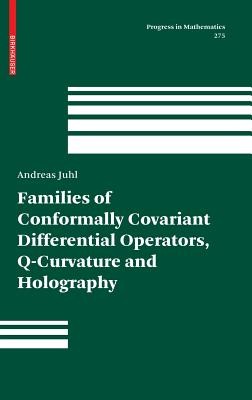
- We will send in 10–14 business days.
- Author: Andreas Juhl
- Publisher: Birkhäuser
- Year: 2009
- Pages: 490
- ISBN-10: 376439899X
- ISBN-13: 9783764398996
- Format: 16 x 22.9 x 3.1 cm, hardcover
- Language: English
- SAVE -10% with code: EXTRA
Families of Conformally Covariant Differential Operators, Q-Curvature and Holography (e-book) (used book) | bookbook.eu
Reviews
Description
A basic problem in geometry is to ?nd canonical metrics on smooth manifolds. Such metrics can be speci?ed, for instance, by curvature conditions or extremality properties, and are expected to contain basic information on the topology of the underlying manifold. Constant curvature metrics on surfaces are such canonical metrics. Their distinguished role is emphasized by classical uniformization theory. Amorerecentcharacterizationofthesemetrics describes them ascriticalpoints of the determinant functional for the Laplacian.The key tool here is Polyakov'sva- ationalformula for the determinant. In higher dimensions, however, it is necessary to further restrict the problem, for instance, to the search for canonical metrics in conformal classes. Here two metrics are considered to belong to the same conf- mal class if they di?er by a nowhere vanishing factor. A typical question in that direction is the Yamabe problem ([165]), which asks for constant scalar curvature metrics in conformal classes. In connection with the problem of understanding the structure of Polyakov type formulas for the determinants of conformally covariant di?erential operators in higher dimensions, Branson ([31]) discovered a remarkable curvature quantity which now is called Branson's Q-curvature. It is one of the main objects in this book.
EXTRA 10 % discount with code: EXTRA
The promotion ends in 19d.21:57:27
The discount code is valid when purchasing from 10 €. Discounts do not stack.
- Author: Andreas Juhl
- Publisher: Birkhäuser
- Year: 2009
- Pages: 490
- ISBN-10: 376439899X
- ISBN-13: 9783764398996
- Format: 16 x 22.9 x 3.1 cm, hardcover
- Language: English English
A basic problem in geometry is to ?nd canonical metrics on smooth manifolds. Such metrics can be speci?ed, for instance, by curvature conditions or extremality properties, and are expected to contain basic information on the topology of the underlying manifold. Constant curvature metrics on surfaces are such canonical metrics. Their distinguished role is emphasized by classical uniformization theory. Amorerecentcharacterizationofthesemetrics describes them ascriticalpoints of the determinant functional for the Laplacian.The key tool here is Polyakov'sva- ationalformula for the determinant. In higher dimensions, however, it is necessary to further restrict the problem, for instance, to the search for canonical metrics in conformal classes. Here two metrics are considered to belong to the same conf- mal class if they di?er by a nowhere vanishing factor. A typical question in that direction is the Yamabe problem ([165]), which asks for constant scalar curvature metrics in conformal classes. In connection with the problem of understanding the structure of Polyakov type formulas for the determinants of conformally covariant di?erential operators in higher dimensions, Branson ([31]) discovered a remarkable curvature quantity which now is called Branson's Q-curvature. It is one of the main objects in this book.


Reviews